Developer Guide
Table of Contents
- Acknowledgements
- Setting up and getting started
- Design
-
Implementation
- Add Features (
add-developer,add-client,add-project) - Delete Features (
delete-developer,delete-client) - Import Features (
import-developer,import-client) - Find Features (
find-developer,find-client,find-project) - Edit Features (
edit-developer,edit-client,edit-project) - List Features (
list-developer,list-client,list-project) - Undo/redo Features (
undo,redo) - Add-role Feature (
add-developer-role,add-client-role) - Delete-role Feature (
delete-developer-role,delete-client-role) - GUI Feature
- Add Features (
- Documentation, logging, testing, configuration, dev-ops
- Appendix: Requirements
- Appendix: Manual Testing
- Appendix: Planned Enhancements
- Appendix: Effort
Acknowledgements
- Adapted from AB3
- This project uses Ratings Bar from ControlsFX
Scroll back to Table of Contents
Setting up and getting started
- Refer to the guide Setting up and getting started.
Scroll back to Table of Contents
Design
.puml files used to create diagrams in this document docs/diagrams folder. Refer to the PlantUML Tutorial at se-edu/guides to learn how to create and edit diagrams.
Architecture

The Architecture Diagram given above explains the high-level design of the App.
Given below is a quick overview of main components and how they interact with ea
Main components of the architecture
Main (consisting of classes Main and MainApp) is in charge of the app launch and shut down.
- At app launch, it initializes the other components in the correct sequence, and connects them up with each other.
- At shut down, it shuts down the other components and invokes cleanup methods where necessary.
- The bulk of the app’s work is done by the following four components:
Commons represents a collection of classes used by multiple other components.
How the architecture components interact with each other
The Sequence Diagram below shows how the components interact with each other for the scenario where the user issues the command delete-developer 1.

Each of the four main components (also shown in the diagram above),
- defines its API in an
interfacewith the same name as the Component. - implements its functionality using a concrete
{Component Name}Managerclass (which follows the corresponding APIinterfacementioned in the previous point).
For example, the Logic component defines its API in the Logic.java interface and implements its functionality using the LogicManager.java class which follows the Logic interface. Other components interact with a given component through its interface rather than the concrete class (reason: to prevent outside component’s being coupled to the implementation of a component), as illustrated in the (partial) class diagram below.

The sections below give more details of each component.
Scroll back to Table of Contents
UI component
The API of this component is specified in Ui.java

The UI consists of a MainWindow that is made up of parts e.g.CommandBox, ResultDisplay, DeveloperListPanel, ClientListPanel, ProjectListPanel, StatusBarFooter etc. All these, including the MainWindow, inherit from the abstract UiPart class which captures the commonalities between classes that represent parts of the visible GUI.
The UI component uses the JavaFx UI framework. The layout of these UI parts are defined in matching .fxml files that are in the src/main/resources/view folder. For example, the layout of the MainWindow is specified in MainWindow.fxml
The UI component,
The UI component,
- executes user commands using the Logic component.
- listens for changes to Model data so that the UI can be updated with the modified data.
- keeps a reference to the Logic component, because the UI relies on the Logic to execute commands.
- depends on some classes in the Model component, as it displays
Developer,Client,Projectobjects residing in the Model.
Main Window
The MainWindow houses all the components that make up the visual display of CodeContact. Its primary function is to listen to user input through the CommandBox, initiate the execution of the command, and display the result through the ResultDisplay and/or tabPane. The tabPane houses the DeveloperListPanel, ClientListPanel and ProjectListPanel, which are responsible for displaying the list of developers, clients and projects respectively. The MainWindow also houses the StatusBarFooter, which displays the current status of the application.
Here is a table containing a brief description of the purpose of the smaller components within MainWindow
| Component | Description |
|---|---|
CommandBox |
The CommandBox is where the user enters commands to be executed. |
ResultDisplay |
The ResultDisplay displays the result of the command execution. |
DeveloperListPanel |
The DeveloperListPanel displays the list of developers. |
ClientListPanel |
The ClientListPanel displays the list of clients. |
ProjectListPanel |
The ProjectListPanel displays the list of projects. |
StatusBarFooter |
The StatusBarFooter displays the current status of the application. |
HelpWindow |
Displays a help window containing a link to the User Guide. |
Scroll back to Table of Contents
Logic component
API : Logic.java
Here’s a (partial) class diagram of the Logic component:

The sequence diagram below illustrates the interactions within the Logic component, taking execute("delete-client 1") API call as an example.
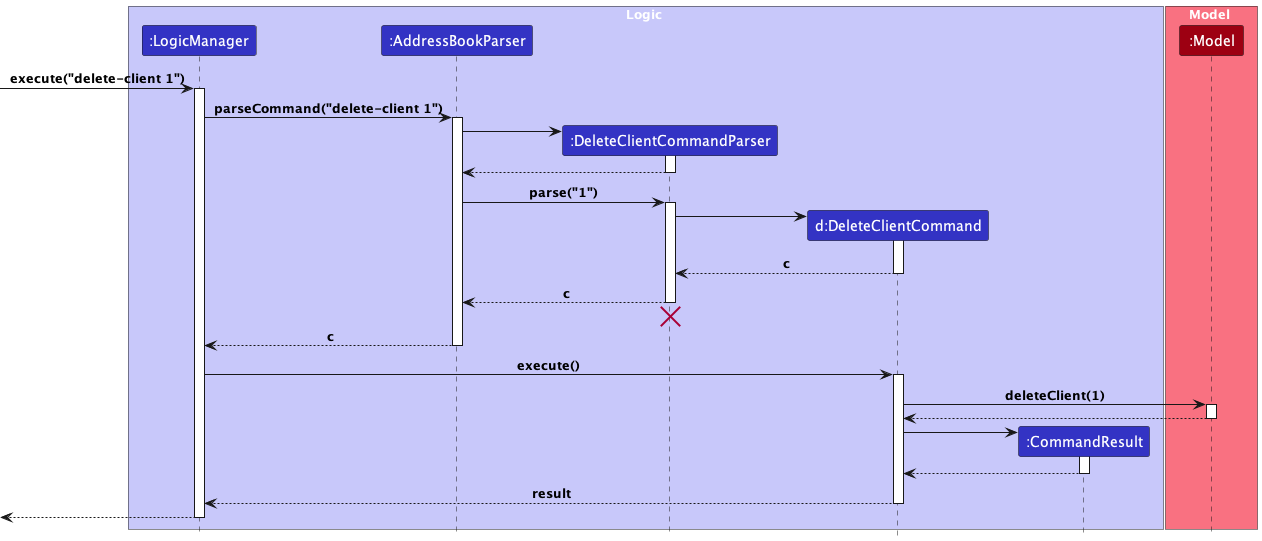
DeleteCommandParser should end at the destroy marker (X) but due to a limitation of PlantUML, the lifeline reaches the end of diagram.
How the Logic component works:
- When
Logicis called upon to execute a command, it is passed to anAddressBookParserobject which in turn creates a parser that matches the command (e.g.,DeleteDeveloperCommandParser) and uses it to parse the command. - This results in a
Commandobject (more precisely, an object of one of its subclasses e.g.,DeleteDeveloperCommand) which is executed by theLogicManager. - The command can communicate with the
Modelwhen it is executed (e.g. to delete a developer). - The result of the command execution is encapsulated as a
CommandResultobject which is returned back fromLogic.
Here are the other classes in Logic (omitted from the class diagram above) that are used for parsing a user command:

How the parsing works:
- When called upon to parse a user command, the
AddressBookParserclass creates anXYZCommandParser(XYZis a placeholder for the specific command name e.g.,AddCommandParser) which uses the other classes shown above to parse the user command and create aXYZCommandobject (e.g.,AddProjectCommand) which theAddressBookParserreturns back as aCommandobject. - All
XYZCommandParserclasses (e.g.,AddDeveloperCommandParser,DeleteClientCommandParser, …) inherit from theParserinterface so that they can be treated similarly where possible e.g, during testing.
Model component
API : Model.java

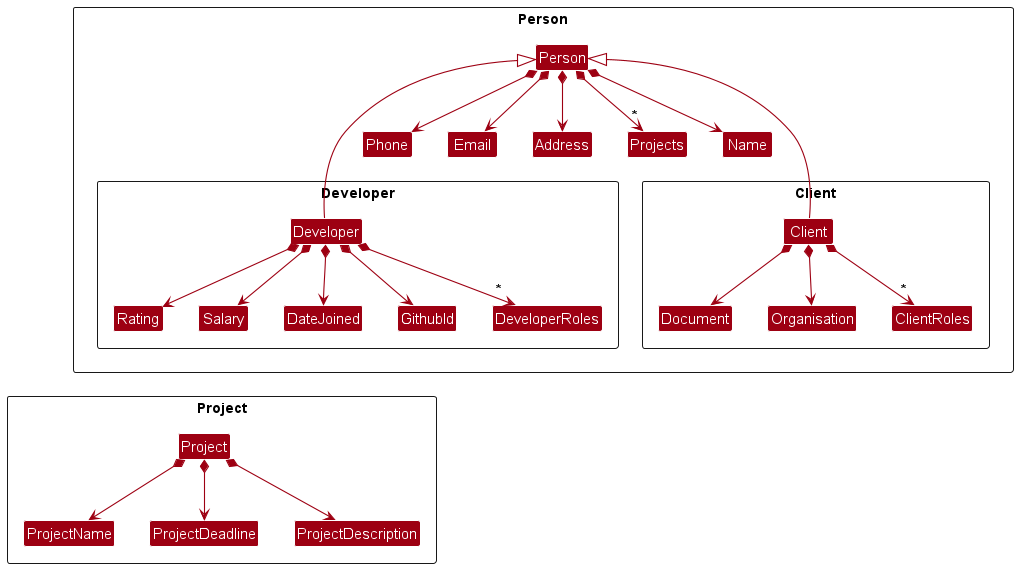
The Model component,
- stores the address book data i.e., all
Developerobjects (which are contained in aUniqueDeveloperListobject), and similarly so forClientandProjectobjects. - stores the currently ‘selected’
Developerobjects (e.g., results of a search query) as a separate filtered list which is exposed to outsiders as an unmodifiableObservableList<Developer>that can be ‘observed’ e.g. the UI can be bound to this list so that the UI automatically updates when the data in the list change. This is similar forClientandProjectobjects. - stores a
UserPrefobject that represents the user’s preferences. This is exposed to the outside as aReadOnlyUserPrefobjects. - does not depend on any of the other three components (as the
Modelrepresents data entities of the domain, they should make sense on their own without depending on other components)
Project list in the AddressBook, which Developer/Client references. This allows CodeContact to only require one Project object per unique Project, instead of each Developer/Client needing their own set of Strings holding the Project names.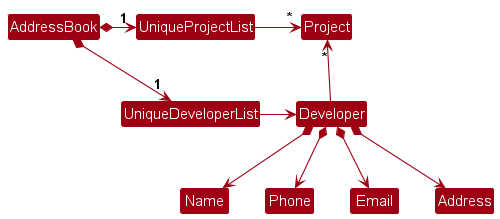
Storage component
API : Storage.java

The Storage component,
- can save both address book data and user preference data in JSON format, and read them back into corresponding objects.
- inherits from both
AddressBookStorageandUserPrefStorage, which means it can be treated as either one (if only the functionality of only one is needed). - depends on some classes in the
Modelcomponent (because theStoragecomponent’s job is to save/retrieve objects that belong to theModel)
Common classes
Classes used by multiple components are in the seedu.address.commons package.
This section describes some noteworthy details on how certain features are implemented.
Implementation
Add Features (add-developer, add-client, add-project)
Example Uses:
add-developer n/Mahidharah p/81256788 e/aunus@nus.com a/Blk 88 Lorong 8 Serangoon Gardens, #08-88 r/Developer pr/Appollo pr/Orbital s/8880 d/20-10-2020 g/mahidharah88 rt/5.0
add-client n/Mahidharah p/81256788 e/aunus@nus.com a/Blk 88 Lorong 8 Serangoon Gardens, #08-88 r/HR pr/Appollo pr/Orbital o/Google do/google.com
add-project n/Tp dr/Team Project dl/19-12-2023,Design backend,HIGH,0 dl/21-12-2023,Design frontend,LOW,1
Intended Result
Adds a developer, client or project to the address book, and adds them to the bottom of the list of exisitng developers, clients or projects respectively. The newly added developer, client or project will be displayed in the list of developers, clients or projects respectively. If the developer, client or project already exists in the address book, the command will not be allowed and an error will be thrown to alert user.
Implementation
Upon entry of the add-developer command for instance, an AddDeveloperCommand class is created. The AddDeveloperCommand class extends the abstract Command class and implements the execute() method. Upon execution of this method, a Developer object is added to the model’s list of developers if all the attributes provided are valid and a duplicate instance does not exist.
A similar implementation is done for the add-client and add-project commands, where a AddClientCommand and AddProjectCommand class (which similarly extend the Command class) is created respectively to add a Client or Project object to the model’s list of clients or projects.
Given below is an example usage scenario of how the add developer is executed step by step.
Step 1. User launches the application and unlocks the application with the correct password.
Step 2. User executes an add-developer command by entering add-developer n/Mahidharah p/81256788 e/aunus@nus.com a/Blk 88 Lorong 8 Serangoon Gardens, #08-88 r/Developer pr/Appollo pr/Orbital s/8880 d/20-10-2020 g/mahidharah88 rt/5.0
Step 3. The developer is added to the model’s list of developers if valid.
add-client and add-project commands are executed in a similar manner.
The following sequence diagram illustrates how the add developer operation works
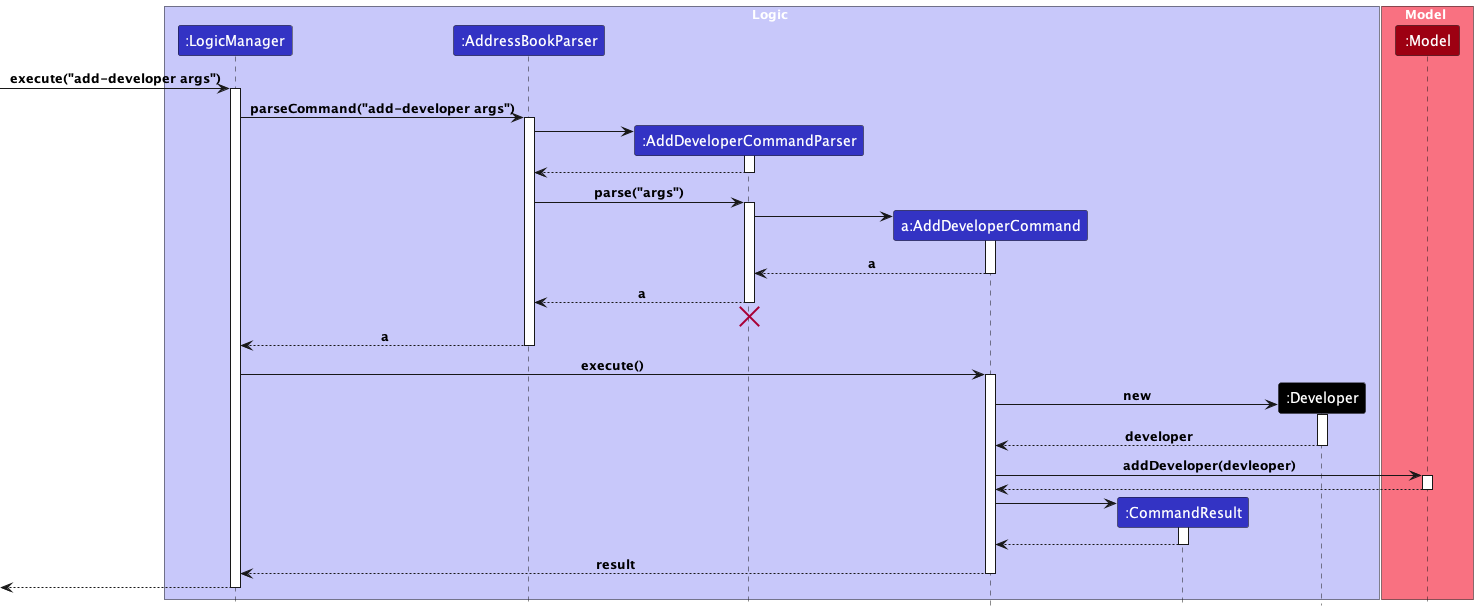
Scroll back to Table of Contents
Delete Features (delete-developer, delete-client)
Intended Result
Deletes a developer or client at the specified one-based index of list of currently existing/found developers or clients respectively, depending on the command. Users are able to delete any developers or clients in their respective lists. If an index larger than or equal to the size of the respective lists provided, the command will not be allowed and an error will be thrown to alert user.
Example Uses:
delete-developer 3
delete-client 2
Implementation
Upon entry of the delete developer command for instance, a DeleteDeveloperCommand class is created. The DeleteDeveloperCommand class extends the abstract Command class and implements the execute() method. Upon execution of this method, the developer at specified one-based index is removed if the index provided is valid.
Given below is an example usage scenario of how the delete developer command behaves at each step.
Step 1. User launches the application and unlocks the application with the correct password.
Step 2. User executes a delete-developer command by entering delete-develoepr 1 to delete the developer at index 1 (one-based indexing)
Step 3. The developer at this index is removed if the index provided is valid.
A similar implementation is done for the delete-client command, where a DeleteClientCommandclass (which similarly extend the Command class) is created respectively to delete a Client object from the model’s list of clients.
The following sequence diagram illustrates how the delete developer operation works:

Scroll back to Table of Contents
Delete Project Feature (delete-project)
Intended Result
Deletes a project at the specified one-based index of list of currently existing/found projects. Users are able to delete any project in project lists. If an index larger than or equal to the size of the project list provided, the command will not be allowed and an error will be thrown to alert user. Additionally, if the project is assigned to a developer or client, the project will be removed from the developer or client’s set of projects.
Example Uses:
delete-project 2
Implementation
Upon entry of the delete project command, a DeleteProjectCommand class is created. The DeleteProjectCommand class extends the abstract Command class and implements the execute() method. Upon execution of this method, the project at specified one-based index is removed if the index provided is valid.
Given below is an example usage scenario of how the delete developer command behaves at each step.
Step 1. User launches the application and unlocks the application with the correct password.
Step 2. User executes a delete-project command by entering delete-project 1 to delete the project at index 1 (one-based indexing)
Step 3. The project at this index is removed if the index provided is valid. Developer and Client lists are iterated through and the project is removed from the respective project sets if the project is assigned to them.
This is similar to delete-developer and delete-client commands, except that in the delete project method is called in the model, the project is also removed from the respective developer and client’s project sets. The following sequence diagram illustrates how the delete-project operation works:
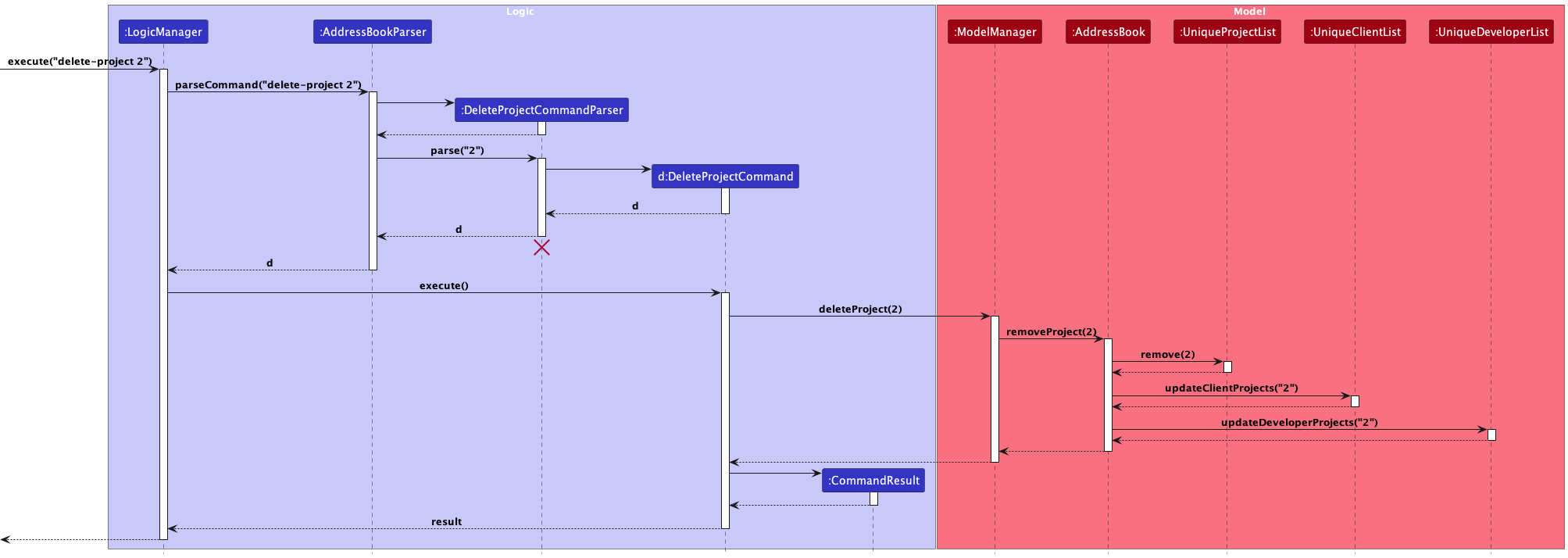
Design considerations
-
Alternative 1: Make the delete-project command call edit-developer and edit-client commands, both to update the project sets of the respective developers and clients.
- Pros: Easy to implement.
- Cons: May be less efficient as the edit-developer and edit-client commands will have to be called for each developer and client respectively.
- Edit command will have to retrieve client and developer project sets, iterate through each set to edit them accordingly and then pass the command, which will be retrieving information from the model to the logic component, which will complicate and potentially break abstractions originally in place.
-
Alternative 2: Do not edit developer and client project sets
- Pros: No extra logic needed to be implemented.
- Cons: Information integrity is compromised as the project will still be assigned to the developer and client even after it is deleted, and this will affect other features such as find, and potentially future features.
- Alternative 3 (current choice): The delete project method in the model will iterate through developers and clients to make necessary changes to their project sets. * Pros: Information integrity is maintained. Abstractions in place are not broken. Complies with implemented Validation checks. * Cons: Implementation is hidden in the model component, and might not be intuitive in a glance in the logic component.
Scroll back to Table of Contents
Import Feature (import-developer, import-client)
This feature will allow project managers to import existing spreadsheets of developer and client data in the specified format in CSV
Implementation
Upon entry of the import developer command, an ImportDeveloperCommand class is created. The ImportDeveloperCommand class extends the abstract Command class and implements the execute() method. Upon execution of this method, a list of Developer objects are added to the model’s list of developers if all the attributes provided are valid and a duplicate instance does not exist.
Given below is an example usage scenario of how the import developer is executed step by step.
Step 1. User launches the application
Step 2. User inputs import-developer developers.csv to indicate path and filename of where the spreadsheet of developers is located.
Step 3. The developers are added to the model’s list of developers if valid the column names are valid and each row of input is valid.
The implementation follows likewise for clients.
The following sequence diagram illustrates how the import developer operation works:
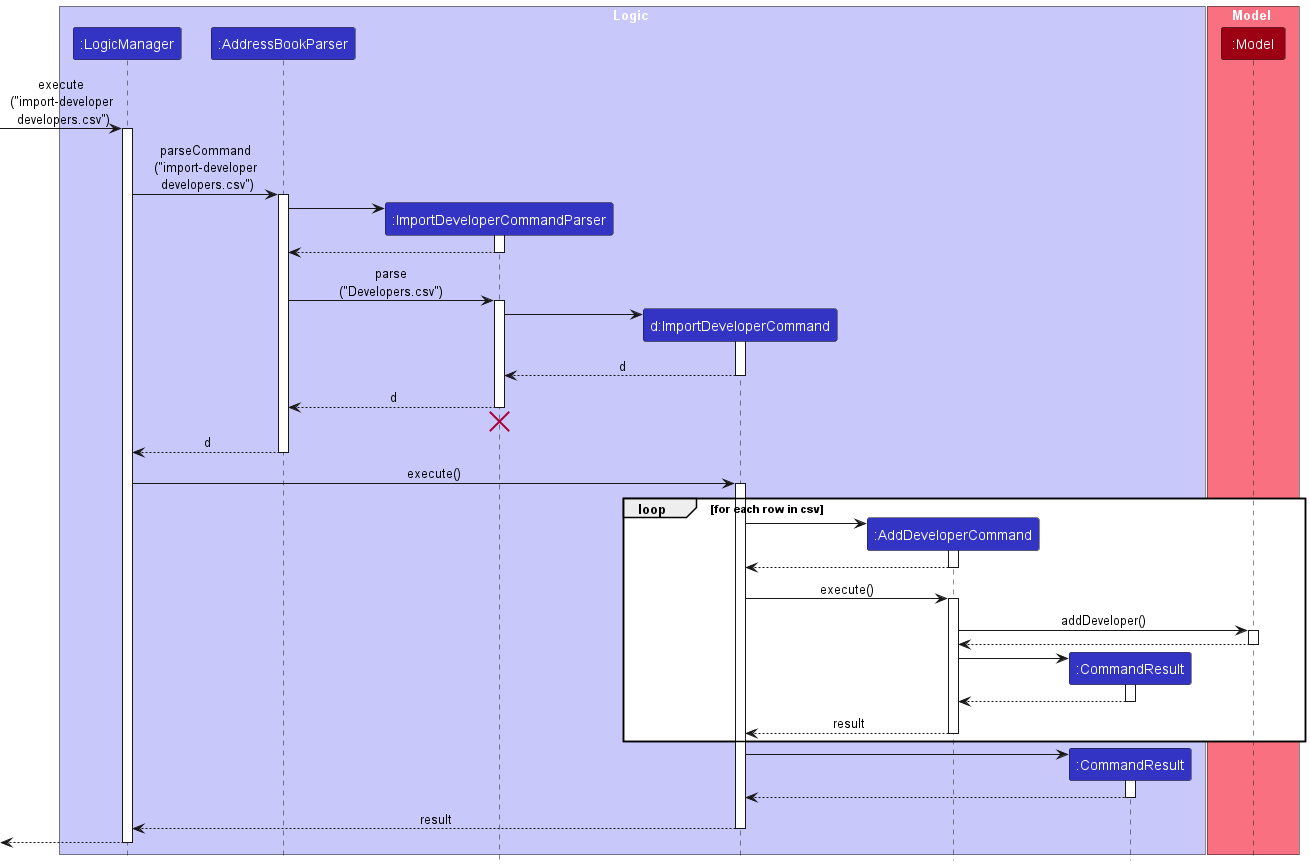
Scroll back to Table of Contents
Edit Feature (edit-developer, edit-client, edit-project)
Implementation
The original edit feature from AB-3 has been extended to account for the editing of projects and specific people - developers and clients. The edit command will be parsed to return 1 of 3 different commands, depending on the object to be edited.
The AddressBookParser will return the respective parser for the command depending on the user input in accordance to the
respective command words defined in CliSyntax. Namely,
-
edit-developerwill return anEditDeveloperCommandParserthat parses the user input and creates anEditDeveloperCommand -
edit-clientwill return anEditClientCommandParserthat parses the user input and creates anEditClientCommand -
edit-projectwill return anEditProjectCommandParserthat parses the user input and creates anEditProjectCommand
Each instance of EditDeveloperCommand, EditClientCommand, and EditProjectCommand objects have 2 private fields:
- an instance of
Indexcontaining the index of the target object to edit in the currently displayed list, and - an instance of
EditDeveloperDescriptor,EditClientDescriptor, orEditProjectDescriptorrespectively, which contains the edited fields to update the target object with.
Executing the command will replace the existing object in the current model with the new object with the edited fields.
Other than extending the commands, parsers, and descriptors to account for Developer, Client, and Project separately,
some changes to the sequence of interactions between the Logic and Model components were also made. When
EditDeveloperCommand and EditClientCommand is executed with edits made to a Project assigned to a Developer or
Client, it calls Model#areProjectsValid() to check whether there is an existing Project with that name.
Given below is an example usage scenario where the user edits the projects assigned to a Developer using the edit-developer
command.
Step 1. User launches the application and unlocks the application with the correct password.
Step 2. User executes an edit developer command by entering edit-developer 1 pr/AppleApp to edit the projects assigned
to the developer at index 1 (one-based indexing) in the currently displayed developer list.
Step 3. The developer at index 1 is edited to be assigned to the project AppleApp given that there is an existing
project with the name AppleApp in the address book.
The sequence diagram below illustrates key interactions taking place in the Logic component when the command
edit-developer 1 pr/AppleApp is called. A significant modification to take note off is the call to the
Model#areProjectsValid() method. The sequence diagram below reflects a successful command execution.
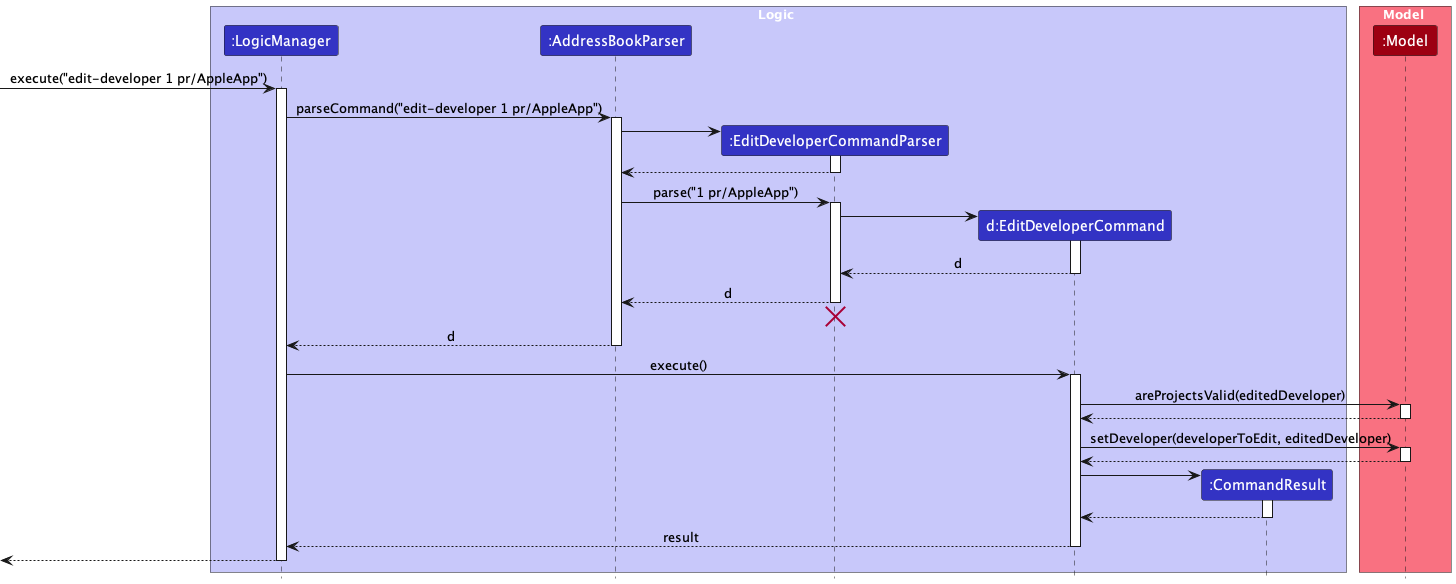
The edit-client and edit-project commands are executed similarly, except project validation checks using the
Model#areProjectsValid() method are not conducted for the latter.
Design considerations
Aspect: Command syntax
-
Alternative 1 (current choice): Have separate commands for each
Developer,Client, andProject. Executing the command automatically switches user to the respective tab.- Pros: More specific and straightforward, allowed parameters in command are easier to navigate for users. More flexible as do not need to be in respective tab to edit.
- Cons: More classes to create, user needs to type more.
-
Alternative 2: Have one general
editcommand. The edit will be made based on the current tab displayed.- Pros: User as can be less specific when typing command.
- Cons: User needs to ensure that intended tab is open. Allowed parameters are less clearly defined, can lead to confusion and mistakes.
Scroll back to Table of Contents
Find Feature (find-developer, find-client, find-project)
Implementation
The find feature is facilitated by a map-based strategy, associating specific prefixes (e.g., “find-developer n/” or “find-client r/”) with corresponding predicates, allowing dynamic generation of filtering criteria based on user input.
Implemented operations include:
-
FindCommandParser#parse(): Interprets the user’s input and generates the appropriate predicate to filter the list of developers or clients. -
Model#updateFilteredPersonList(): Updates the list displayed in the UI based on the provided predicate.
Given below is an example usage scenario and how the find mechanism behaves at each step:
Step 1. The user launches the application. The list of developers and clients are displayed.
Step 2. To filter developers by name, the user executes the command find-developer n/ alice bob. The application recognizes the “developer n/” prefix and uses the NameContainsKeywordsPredicate to generate a filtering criteria. The list in the UI is updated to only display developers named Alice or Bob.
Step 3. Next, the user wants to find clients from a specific organisation. They use the command find-client o/Google. The “find-client o/” prefix maps to the OrganisationContainsKeywordsPredicate and filters clients associated with Google.
Step 4. If the user provides an unrecognized prefix, e.g., find-developer z/ alice, an error message is displayed informing them of the correct command format.
Note: The following sequence diagram provides an overview of how the find operation is executed:
The following sequence diagram provides an overview of how the find operation is executed
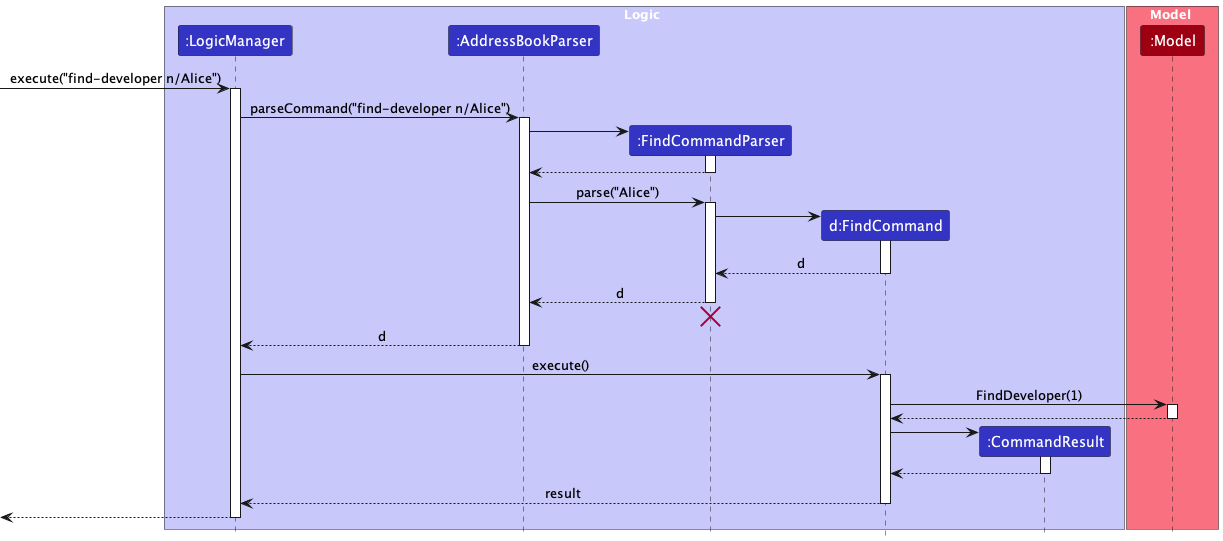
Design considerations
Aspect: Implementation of the predicate map:
Alternative 1:
- Use a long chain of
if-elseconditions for each attribute.- Pros: Explicit parsing logic for each attribute.
- Cons: Code becomes lengthy and hard to maintain. Adding a new attribute involves modifying the parsing logic, increasing the risk of errors.
Alternative 2 (current choice):
- Use a map linking prefixes to their corresponding predicate constructors.
- Pros: Simplifies the parsing process. Adding a new attribute to search becomes as simple as adding a new entry in the map.
- Cons: A potential mismatch between the prefix and its predicate can lead to wrong results.
Given the benefits of a more maintainable and scalable codebase, we’ve decided to go with the first alternative. Future enhancements might include fuzzy search.
Scroll back to Table of Contents
List Feature (list-developer, list-client, list-project)
Implementation
The list command employs a structured approach where specific commands, such as list-developer or list-client
are associated with corresponding functionalities. This allows users to efficiently retrieve
information about developers, clients or projects by specifying the relevant prefix, streamlining the process of
generating targeted lists based on user input.
Implemented operations include:
-
<TYPE>here refers to developer, client or project -
AddressBookParser: Interprets the user’s input and calls the appropriateList<TYPE>Command#execute()to print the relevant lists of data -
Model#updateFiltered<TYPE>List: Update the list displayed in the UI to print all the existing developers ,clients or projects.
Given below is an example usage scenario and how the list mechanism behaves at each step:
Step 1. The user used the find feature to search for something and the UI is only displaying some
developers
Step 2. To list all the developers, the user executes the command list-developer. AddressBookParser
recognizes the list-developer command and calls the ListDeveloperCommand.
Step 3. Next, the ListDeveloperCommand#execute() method that overides the abstract method Command#execute() gets
activated.This execute() method calls the Model#updateFilteredDeveloperList, passing in the Predicate<Developer>
that has been set to true.
Step 4. Model#updateFilteredDeveloperList then updates the list in the UI to print all the existing developers.
The following sequence diagram provides an overview of how the find operation is executed
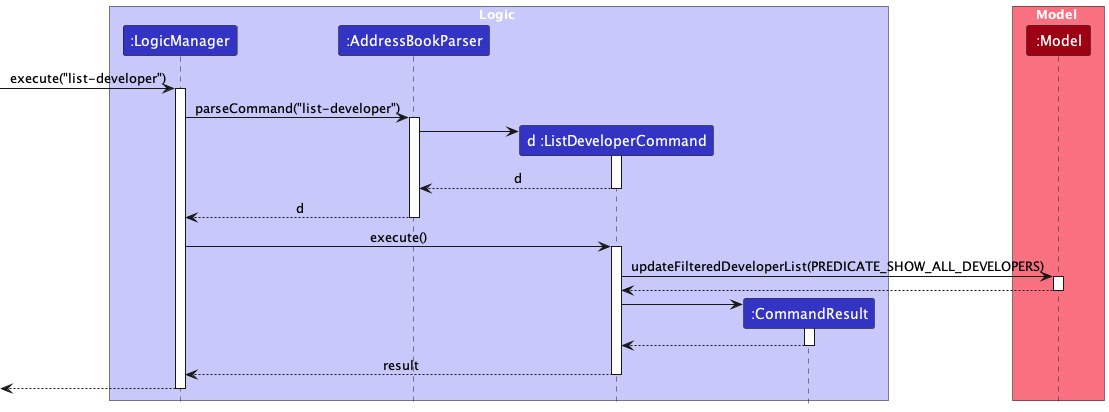
Scroll back to Table of Contents
Undo/redo Feature (undo, redo)
Implementation - undo
The proposed undo/redo mechanism is facilitated by VersionedAddressBook. It extends AddressBook with an undo/redo
history, stored internally as an addressBookStateList and currentStatePointer. Customised to the functions of CodeContact to
have a more helpful message and automatic tab switch, the history for messages and tabs are also stored internally as
successfulCommandMessages and tabIndex.
Additionally, it implements the following operations:
-
VersionedAddressBook#commit()— Saves the current address book state in its history. -
VersionedAddressBook#undo()— Restores the previous address book state from its history. -
VersionedAddressBook#redo()— Restores a previously undone address book state from its history.
These operations are exposed in the Model interface as Model#commitAddressBook(), Model#undoAddressBook() and Model#redoAddressBook() respectively.
Given below is an example usage scenario and how the undo/redo mechanism behaves at each step.
Step 1. The user launches the application for the first time. The VersionedAddressBook will be initialized with the initial address book state, and the currentStatePointer pointing to that single address book state.
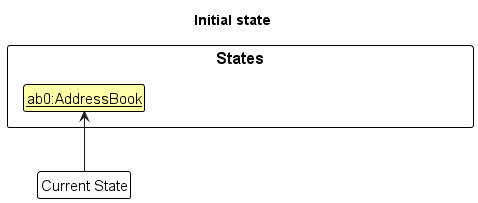
Step 2. The user executes delete-developer 5 command to delete the 5th developer in the address book. The delete
command calls Model#commitAddressBook(), causing the modified state of the address book after the delete-developer 5
command executes to be saved in the addressBookStateList. The successful command message and tab it switched to
also saved into successfulCommandMessages and tabIndex respectively. The currentStatePointer is then shifted to the newly
inserted address book state.
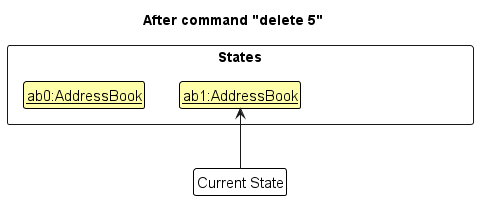
Step 3. The user executes add-developer n/David … to add a new developer. The add command also calls
Model#commitAddressBook(), causing another modified address book state to be saved into the addressBookStateList,
and another successful command message and tab switched saved into successfulCommandMessages and tabIndex.
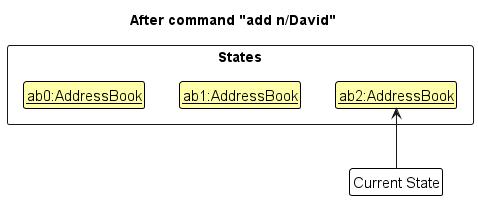
Model#commitAddressBook(), so the address book state will not be saved into the addressBookStateList.
Step 4. The user now decides that adding the developer was a mistake, and decides to undo that action by executing the undo command. The undo command will call Model#undoAddressBook(), which will shift the currentStatePointer once to the left, pointing it to the previous address book state, and restores the address book to that state.
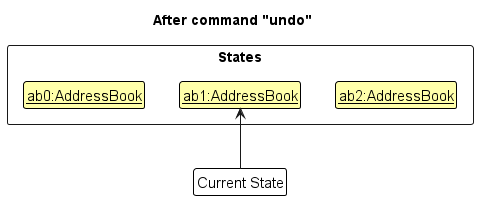
The following sequence diagram shows how the undo operation works:
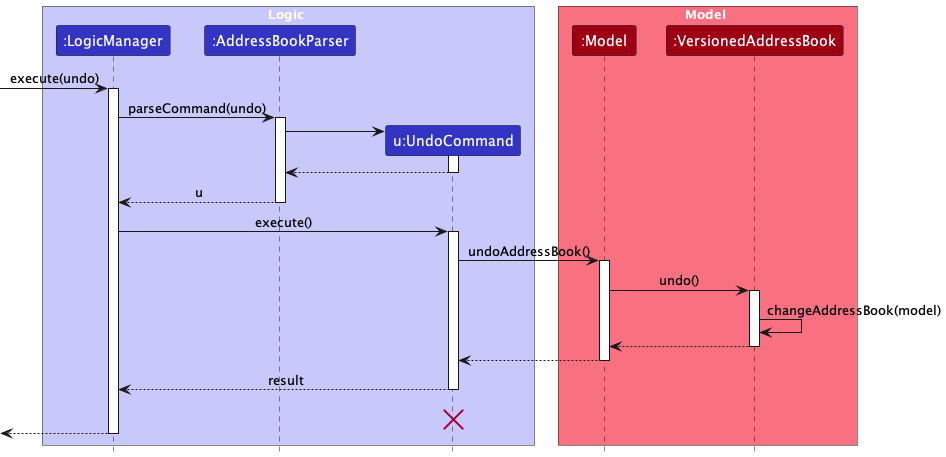
Scroll back to Table of Contents
Implementation - redo
The redo command does the opposite — it calls Model#redoAddressBook(), which shifts the currentStatePointer once to the right, pointing to the previously undone state, and restores the address book to that state.
currentStatePointer is at index addressBookStateList.size() - 1, pointing to the latest address book state, then there are no undone AddressBook states to restore. The redo command uses Model#canRedoAddressBook() to check if this is the case. If so, it will return an error to the user rather than attempting to perform the redo.
Step 5. The user then decides to execute the command list. Commands that do not modify the address book, such as list, will usually not call Model#commitAddressBook(), Model#undoAddressBook() or Model#redoAddressBook(). Thus, the addressBookStateList remains unchanged.
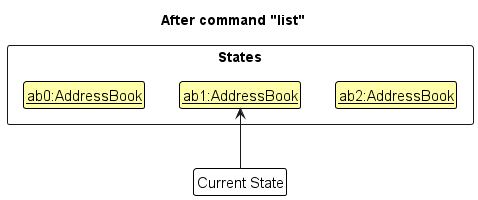
Design considerations
Aspect: How undo & redo executes:
-
Alternative 1 (current choice): Saves the entire address book.
- Pros: Easy to implement.
- Cons: May have performance issues in terms of memory usage.
-
Alternative 2 (part of current choice): Individual command knows how to undo/redo by itself.
- Pros: Will use less memory (e.g. for
delete, just save the developer being deleted). - Cons: We must ensure that the implementation of each individual command are correct.
- Due to a special parameter
rolehaving its own add and delete functions which are separated from the model and not stored in address book, it uses alternative 2 wherebyundoanadd-developer-rolewill just execute thedelete-developer-role function. The process of this implementation had to be very careful just like what the cons mentioned, a slight validation error can change the wholeundoandredofeature.
- Pros: Will use less memory (e.g. for
Scroll back to Table of Contents
Add-role Feature (add-developer-role, add-client-role)
Implementation
The add role command employs a structured approach where specific commands, such as add-developer-role or
add-client-roleare associated with corresponding functionalities. This allows users to efficiently add
information about developers and clients. One of the validation checks when adding a developer or client is that this role
added must exist. This is where users will need this command to add in the respective roles. This feature is facilitated
with the DeveloperRoles and ClientRoles class which implements the following operations:
-
DeveloperRoles#addDeveloperRole()— Adds a developer role into the list of roles stored -
DeveloperRoles#saveDeveloperRoles()— Saves the updated list of developer roles -
DeveloperRoles#loadDeveloperRoles()— Loads the existing list of developer roles from file -
DeveloperRoles#isValidRole()— Checks if this role being added exists already
The classes are similar for ClientRoles but just that they are associated with the clients.
Given below is an example usage scenario and how the add-developer-role mechanism behaves at each step:
Step 1. The user launches the application. The list roles for developers and clients are loaded into a list or roles.
Step 2. The user executes the command add-developer-role Tester. The application recognizes the add-developer-role
and calls AddDeveloperRoleCommandParser#parse().
Step 3. The parser checks if the argument is an empty blank space and trims the input given, in this case ` Tester is
trimmed to Tester and calls AddDeveloperRoleCommand`.
Step 4. AddDeveloperRoleCommand#execute() checks if there is an existing role with the same name and creates
a new developer role if there is no such role.
developer even if Developer exists. The following sequence diagram shows how the Add-role operation works:
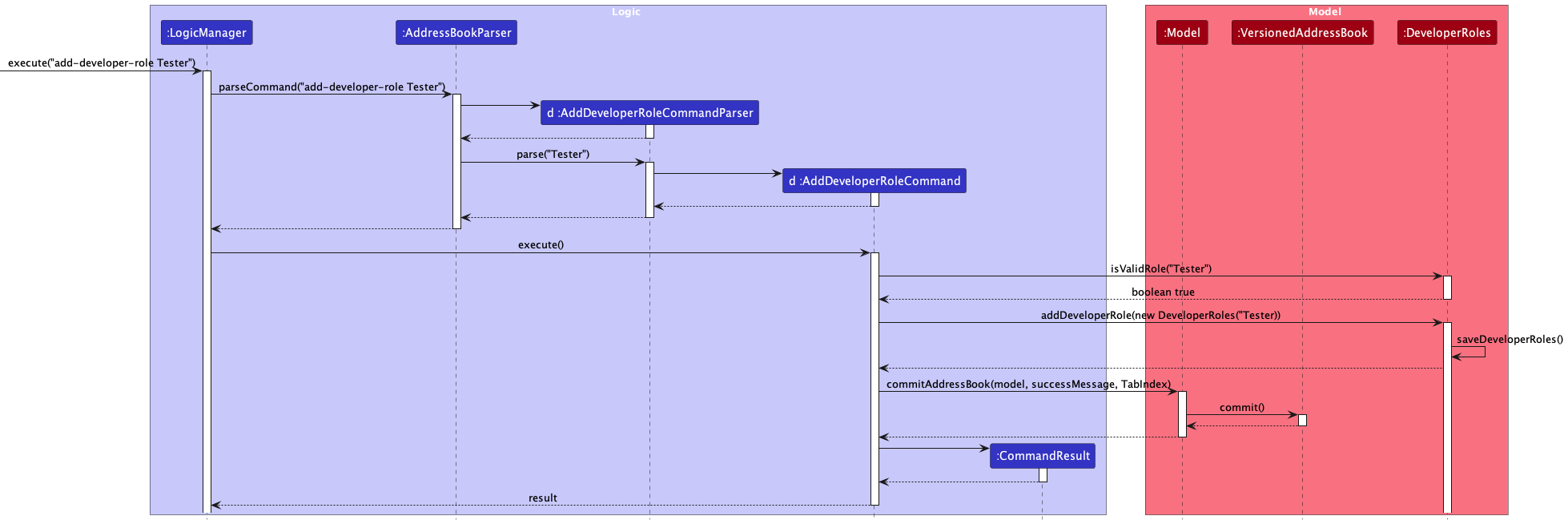
Design considerations
Aspect: How add-role executes:
-
Alternative 1 (current choice): Treat role as a variable, has a separate load and unload list
- Pros: Role can just be treated as an attributed that needs more validation checks
- Cons: Have to load and unload each time system relaunches, quite time and memory consuming
-
Alternative 2: Treating role like another person or project, adding roles are like adding projects
- Pros: Easy to implement.
- Cons: Roles would have to be implemented on the same level as developers, clients and projects which should not be case.
Scroll back to Table of Contents
Delete-role Feature (delete-developer-role, delete-client-role)
Implementation
The add role command employs a structured approach where specific commands, such as delete-developer-role or
delete-client-roleare associated with corresponding functionalities. This allows users to efficiently delete
information about developers and clients that they no longer need. The system helps you to check if there are any
developers or clients in the list using this feature. If there is, the command will not be successfully executed.
This feature is facilitated with the DeveloperRoles and ClientRoles class which implements the following operations:
-
DeveloperRoles#deleteDeveloperRole()— Deletes a developer role into the list of roles stored -
DeveloperRoles#saveDeveloperRoles()— Saves the updated list of developer roles -
DeveloperRoles#loadDeveloperRoles()— Loads the existing list of developer roles from file -
DeveloperRoles#isRemovableRole()— Checks if this role can be deleted; It should not be a pre-determined role, it should not be a non-existing role, it should not be a role that is in use.
The classes are similar for ClientRoles but just that they are associated with the clients.
Given below is an example usage scenario and how the delete-developer-role mechanism behaves at each step:
Step 1. The user launches the application. The list roles for developers and clients are loaded into a list or roles.
Step 2. The user executes the command delete-developer-role Tester. The application recognizes the delete-developer-role
and calls DeleteDeveloperRoleCommandParser#parse().
Step 3. The parser checks if the argument is an empty blank space and trims the input given, in this case ` Tester is
trimmed to Tester and calls DeleteDeveloperRoleCommand`.
Step 4. DeleteDeveloperRoleCommand#execute() checks if this is a removable role and removes it from the list of roles
if DeveloperRoles#isRemovableRole() returns true.
The following sequence diagram shows how the Delete-role operation works:

The following activity diagram shows how the validation check isRemovableRole() works:
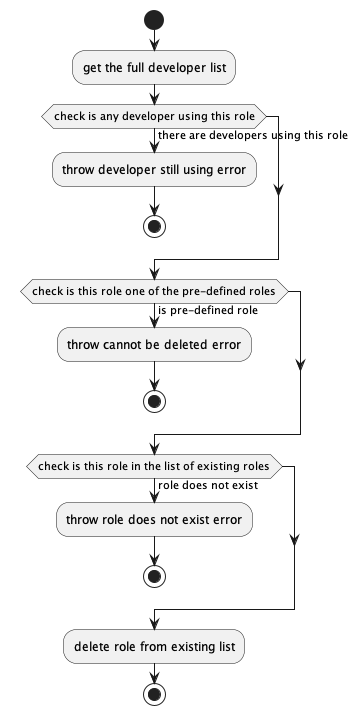
Scroll back to Table of Contents
Mark/unmark deadline Feature (mark-deadline, unmark-deadline)
Implementation
The mark and unmark deadline features are implemented using a secondary call to the edit-project command. As with
the other commands, mark-deadline and unmark-deadline commands are first parsed to return MarkDeadlineCommandParser
and UnmarkDeadlineCommandParser respectively. The parses similarly implement the MarkDeadlineCommandParser#parse()
and UnmarkDeadlineCommandParser#parse() methods which return MarkDeadlineCommand and UnmarkDeadlineCommand objects
respectively. However, in the execution of MarkDeadlineCommand and UnmarkDeadlineCommand, a new
EditProjectCommand is created and subsequently executed, to get the CommandResult.
Consequently, calling mark-deadline and unmark-deadline on a deadline of project is synonymous to editing the
project to update the isDone status of the deadline.
This is facilitated by the following methods:
-
MarkDeadlineCommand#editProjectArgs()— Formats each deadline in a list of String representations into a String that will be used as the arguments parsed by an EditProjectCommandParser. -
Project#markDeadlineStringRep()— Returns a list with each element being the String representation of the respective deadline, with the deadline at the given index marked as done. -
Project#unmarkDeadlineStringRep()— Returns a list with each element being the String representation of the respective deadline, with the deadline at the given index marked as undone.
Relevant checks are conducted at the MarkDeadlineCommand#execute() and UnmarkDeadlineCommand#execute() stages to
ensure the index of the project and the edited deadline passed to the EditProjectCommandParser as arguments for the
EditProjectCommandParser#parse() as arguments are valid.
The following sequence diagram illustrates the interactions taking place in the Logic component when the command
mark-deadline 2 1 is called. The sequence reflects a successful command execution, assuming that the current state of
the displayed project list has a project with the index 2 with at least 1 deadline.
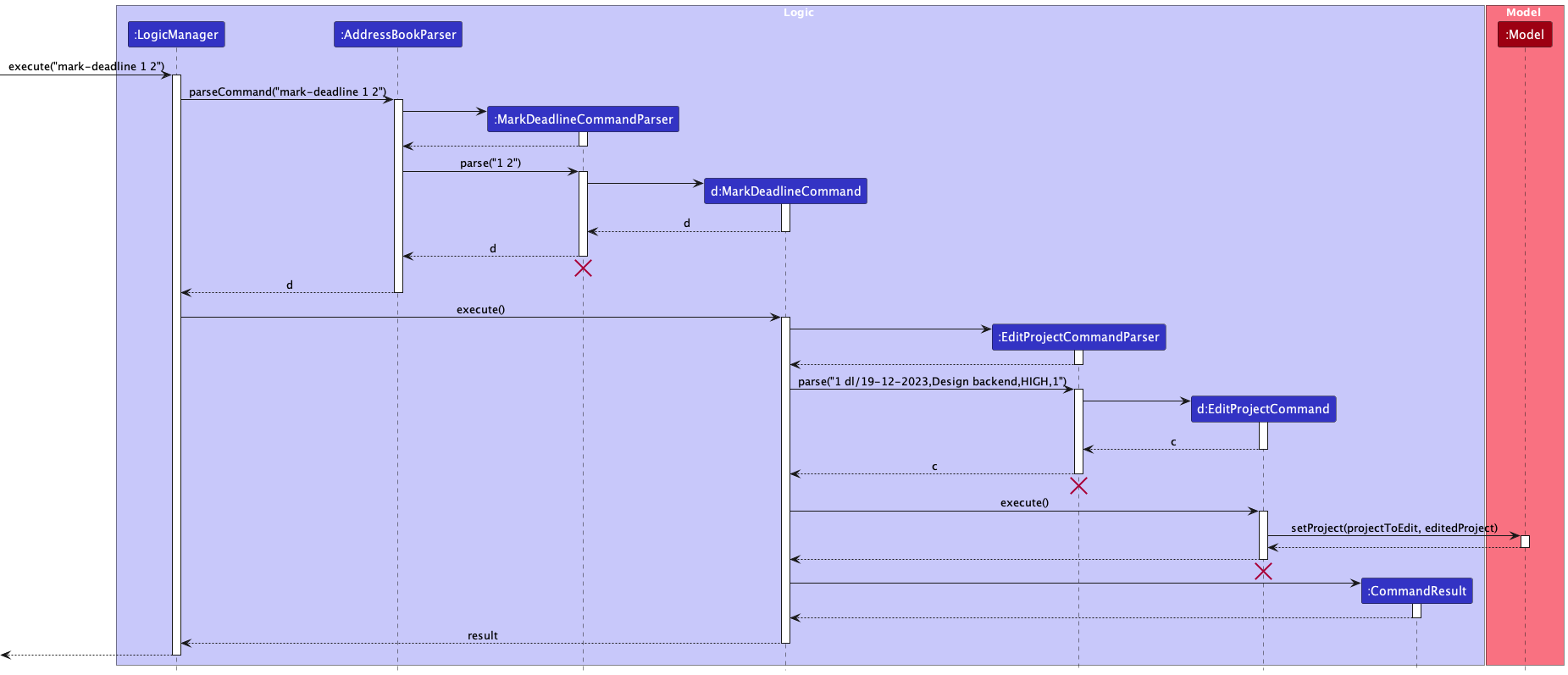
Design considerations
Aspect: Execution of command
-
Alternative 1: Implement methods in
ModelManagerclass that can directly change theisDonestatus of the deadlines of a project based on the given project index and deadline index.- Pros:
- More aligned with OOP principles.
- Mirrors sequence flow of other commands and can be implemented using current code architecture.
- Cons:
- Due to container structure of
ProjectandDeadline, changing the status of deadlines needs to be done through projects, so more methods need to be added to achieve this. - Given the GUI display of project deadlines in a Javafx TableView, makes it more complicated for changes in deadline status to be automatically reflected in the list of projects and deadlines displayed to the user.
- Due to container structure of
- Pros:
-
Alternative 2 (current choice): Implement execution by creating an
EditProjectCommandParserandEditProjectCommandthat will replace the existing project entirely with a new one with the updated deadline being marked/unmarked.- Pros:
- Fewer methods to implement, allows for more reuse.
- Editing the project with new deadlines will ensure that upon execution of the command, the updated project with marked/unmarked deadline is displayed to the user on the app.
- Cons:
- Slightly more disorganised interactions within
Logiccomponent since have to go from parsing a command to executing it, then parsing another command again and executing that command.
- Slightly more disorganised interactions within
- Pros:
Scroll back to Table of Contents
GUI Feature
Switching tabs automatically
When certain commands are executed, the UI will automatically switch to the relevant tab. For example, when the user
executes list-developer, the UI will automatically switch to the Developer tab. This is implemented by specifying
the TabIndex in the CommandResult returned in the execute() method of the relevant command.
Clicking to switch tabs
When the user clicks on a different tab, the list command will be executed to display the relevant list of information
for the tab clicked. This is implemented by adding a listener to the TabPane in the MainWindow class. When the
selected tab changes, the list command will be executed.
Scroll back to Table of Contents
Documentation, logging, testing, configuration, dev-ops
Scroll back to Table of Contents
Appendix: Requirements
Project Scope
Target user profile:
- has a need to manage a significant number of colleague contacts internally
- prefer desktop apps over other types
- can type fast
- prefers typing to mouse interactions
- is reasonably comfortable using CLI apps
- a project manager or someone with similar needs working within a software company
Value proposition: CodeContact aims to seamlessly integrate contact, client, and project management, simplifying access to coding-related contacts, facilitating collaboration, and offering command-line efficiency for project managers.
User stories
Priorities: High (must have) - * * *, Medium (nice to have) - * *, Low (unlikely) - *
| Priority | As a … | I want to … | So that I can… |
|---|---|---|---|
* * * |
project manager | add a list of Developers and their contact information | access contact details easily and quickly assemble teams for new projects |
* * * |
project manager | add a list of Clients and their contact information | access client details easily and know who is related to what project. |
* * * |
project manager | add a list of Projects and their details | access project details easily and see who is related to the project |
* * * |
project manager | delete information about a Client or Developer and the project details will update accordingly | don’t repeat deleting several time |
* * * |
project manager | edit the the details of the Developers added in | constantly update the contact book |
* * * |
project manager | edit the the details of the Clients added in | constantly update the contact book |
* * * |
project manager | edit the the details of the Projects added in | constantly update any changes to the project |
* * * |
project manager | find the the Developers according to any details they have | source for information related to developers easily |
* * * |
project manager | find the the Clients according to any details they have | source for information related to clients easily |
* * * |
project manager | find the the Projects according to any details they have | source for information related to projects easily |
* * * |
project manager | list different groups of people according to the different commands | view projects, clients and developers can be as different lists |
* * * |
project manager | switch between tabs for Developers, Clients and Projects | intuitively view the different data lists |
* * * |
project manager | import data from a csv | transfer data from what i am using right now |
* * |
project manager | add roles | only add people to existing roles in the system so that i do not assign people to random roles |
* * |
project manager | delete roles | remove roles that i think are not useful anymore |
* * |
project manager | undo actions | undo any mistakes i made |
* * |
project manager | redo actions | redo anything i accidentally undid |
* * |
project manager | lock all the data | keep all these data safe |
* * |
project manager | unlock all the data | see all these data after locking it |
* * |
project manager | change password | access these data without worrying data might be stolen |
* * |
project manager | find by deadline | sort out information by deadline due |
* * |
project manager | mark deadline | label out completed deadlines as done |
* * |
project manager | unmark deadline | label out incomplete or reactivated deadlines as undone |
* |
project manager | send reminder emails to the developers when deadlines are nearing | it can remind them that work is due soon |
* |
project manager | give developers feedback directly from CodeContact | reviews can be autogenerated trough my ratings and i need to write a new review each time |
Scroll back to Table of Contents
Use cases
For all use cases below, we assume the following unless specified otherwise
- The System is
CodeContact - The Actor is the
user - The following preconditions
- The
userhas launched theCodeContactapplication.
- The
Furthermore, a lot of use cases are similar when manipulating developers, clients and projects. Therefore, to keep the developer guide concise, the use cases elaborated upon below are only detailed for developers. Nonetheless, they can be extrapolated for clients and projects too, without changes to the major details within the use case. Such associated pairs of use cases are listed in the table below.
| Use Case | Developer command | Client command | Project command |
|---|---|---|---|
| UC3 | Add a developer | Add a client | Add a project |
| UC4 | Delete a developer | Delete a client | Delete a project |
| UC5 | Edit a developer | Edit a client | Edit a project |
| UC6 | Find a developer | Find a client | Find a project |
| UC7 | Add developer role | Add client role | - |
| UC8 | Delete developer role | Delete client role | - |
Use case: UC1 - Unlock System
Preconditions:
- User is not logged in
Guarantees:
- The system will be unlocked and all data will be shown.
MSS
- User requests unlock system with the password.
- System validates if user’s inputs are correct.
-
System logs user in.
Use case ends.
Extensions
- 2a. The password entered is incorrect.
- 2a1. System informs user password entered is incorrect and shows the default password.
- 2a2. User enters password
Steps 2a1-2a2 are repeated until the correct password is entered.
Use case resumes from step 3.
Scroll back to Table of Contents
Use case: UC2 - Change Password
Preconditions:
- User is logged in
Guarantees:
- The system password will be changed.
MSS
- User requests to change password with current password and new password as inputs.
- System validates if user’s new password fulfils the password criteria are correct.
- System changes user’s password.
Use case ends.
Extensions
- 2a. The new password entered is blank or does not follow the format.
- 2a1. System informs user password entered does not follow the format.
- 2a2. User enters new password.
Steps 2a1-2a2 are repeated until the correct password is entered.
Use case resumes from step 3.
- 2b. The current password entered is incorrect.
- 2b1. System informs current password entered is incorrect.
- 2b2. User enters new password.
Steps 2b1-2b2 are repeated until the correct password is entered.
Use case resumes from step 3.
- 2c. The current password is same as new password.
- 2c1. System informs current password is same as new password.
- 2c2. User enters new password.
Steps 2c1-2c2 are repeated until the new password is different.
Use case resumes from step 3.
Scroll back to Table of Contents
Use case: UC3 - Add a developer
Preconditions: User is logged in
Guarantees:
- A new developer will be added to the system after every successful addition
MSS
- User requests to add a developer.
- System requests for the details of the developer.
- User enters the requested details in the required format.
- System validates if the user’s inputs are valid.
-
System adds the developer to the data.
Use case ends.
Extensions
- 4a. The given details are invalid or in an invalid format.
- 4a1. System informs users specifically which data is wrong.
- 4a2. User enters new data.
Steps 4a1-4a2 are repeated until the data entered are correct.
Use case resumes from step 5.
Scroll back to Table of Contents
Use case: UC4 - Delete a developer
Preconditions: User is logged in
Guarantees:
- A developer deleted from the system after every successful delete
MSS
- User requests to delete a developer.
- System requests for the index of the developer.
- User enters the index of the developer.
- System validates if the index is valid.
-
System deletes the developer to the data.
Use case ends.
Extensions
- 4a. The index entered is an invalid number or is not a number.
- 4a1. System requests for the correct index
- 4a2. User enters new index
Steps 4a1-4a2 are repeated until the data entered are correct.
Use case resumes from step 5.
Scroll back to Table of Contents
Use case: UC5 - Edit a developer
Preconditions: User is logged in
Guarantees:
- A developer’s details are edit from the system after every successful edit
MSS
- User requests to edit a developer.
- System requests for the the index of the developer and details of what they wish to change.
- User enters the index of the developer and changed details.
- System validates if index is valid and checks if details changed is valid.
-
System edits the developer’s data.
Use case ends.
Extensions
- 4a. The index entered is an invalid number or is not a number.
- 4a1. System requests for the correct index.
- 4a2. User enters new index.
Steps 4a1-4a2 are repeated until the data entered are correct.
Use case resumes from step 5.
- 4b. The details entered are the same as the existing details.
- 4a1. System informs users the details the same.
- 4a2. User enters new details.
Steps 4b1-4b2 are repeated until the data entered are correct.
Use case resumes from step 5.
- 4c. The details violate certain validation check and is not allowed to change to these details.
- 4a1. System informs users why the details cannot be changed.
- 4a2. User enters new details.
Steps 4c1-4c2 are repeated until the data entered are correct.
Use case resumes from step 5.
Scroll back to Table of Contents
Use case: UC6 - Find a developer
Preconditions: User is logged in
Guarantees:
- A developer is found according to the details entered.
MSS
- User requests to find a developer.
- System requests for the details user wishes to find by.
- User enters the details they wish to find by.
- System searches for developers that matches the details.
-
System shows the relevant developer’s data.
Use case ends.
Extensions
- 3a. There are no details entered.
- 3a1. System informs users input cannot be empty.
- 3a2. User enters new details.
Steps 3a1-3a2 are repeated until the data entered are correct.
Use case resumes from step 4.
- 3b. The details entered are incorrect (eg. entering alphabets when finding by phone).
- Use case just continues to step 4 but will show that no developers are found in step 5.
Scroll back to Table of Contents
Use case: UC7 - Undo
Preconditions: User is logged in
Guarantees:
- The previous command will be undone.
MSS
- User requests undo.
- System checks if there were any changes before.
- System reverts the change.
Use case ends.
Extensions
- 3a. There are no changes before
- 3a1. System informs users they have reached the first step
Use case ends
- 3a1. System informs users they have reached the first step
Scroll back to Table of Contents
Use case: UC8 - Redo
Preconditions: User is logged in
Guarantees:
- The previous command undone will be redone.
MSS
- User requests redo.
- System checks if there were anything undone changes before.
- System redoes the change.
Use case ends.
Extensions
- 3a. There are no undone changes before
- 3a1. System inform users they have reached the last step
Use case ends
- 3a1. System inform users they have reached the last step
Scroll back to Table of Contents
Use case: UC9 - Add developer role
Preconditions: User is logged in
Guarantees:
- A new developer role will be added.
MSS
- User requests to add a developer role.
- User enters the role they want to add.
- System validates if user’s inputs are valid.
- System validates if user’s inputs can be added.
- System adds the developer to the data.
Extensions
- 3a. User enters an empty role
- 3a1. System informs users role cannot be empty and requests for the correct role
- 3a2. User enters new role
Steps 3a1-3a2 are repeated until the data entered is not empty
Use case resumes from step 4.
- 4a. User enters an existing role
- 4a1. System informs users this role exists
- 4a2. User enters new role
Steps 4a1-4a2 are repeated until the data entered is not empty
Use case resumes from step 5.
Scroll back to Table of Contents
Use case: UC10 - Delete developer role
Preconditions: User is logged in
Guarantees:
- A developer role will be deleted.
MSS
- User requests to delete a developer role.
- User enters the role they want to delete.
- System validates if user’s inputs are valid.
- System validates if user’s input can be deleted.
- System adds the developer to the data.
Extensions
- 3a. User enters an empty role
- 3a1. System informs users role cannot be empty and requests for the correct role
- 3a2. User enters correct role
Steps 3a1-3a2 are repeated until the data entered is not empty
Use case resumes from step 4.
- 4a. User enters a role that some developer is still using
- 4a1. System informs users this role cannot be deleted as there are developers using
- 4a2. User enters correct role
Steps 4a1-4a2 are repeated until the data entered is can be deleted
Use case resumes from step 5.
- 4b. User enters a role that doesn’t exist
- 4b1. System informs users this role don’t exist
- 4b2. User enters correct role
Steps 4a1-4a2 are repeated until the data entered is can be deleted
Use case resumes from step 5.
- 4b. User enters a role that cannot be deleted
- 4b1. System informs users this role cannot be deleted as it is a pre-defined role
- 4b2. User enters correct role
Steps 4a1-4a2 are repeated until the data entered can be deleted
Use case resumes from step 5.
Scroll back to Table of Contents
Use case: UC11 - Mark Deadline
Preconditions: User is logged in
Guarantees:
- A project deadline will be marked.
MSS
- User requests to mark the deadline of a project.
- System requests for the index of the project and the index of the deadline.
- User enters relevant indexes.
- System validates if user’s inputs exists.
- System marks the deadline as done.
Extensions
- 3a. User enters an empty index
- 3a1. System informs users indexes should not be empty and requests for the correct role
- 3a2. User enters new indexes
Steps 3a1-3a2 are repeated until the data entered is not empty
Use case resumes from step 4.
- 4a. User enters an invalid index (i.e no project with such index or no deadline in project with this index)
- 4a1. System informs users indexes are invalid
- 4a2. User enters new indexes
Steps 4a1-4a2 are repeated until the data entered is not empty
Use case resumes from step 5. Scroll back to Table of Contents
Use case: UC12 - Unmark Deadline
Preconditions: User is logged in
Guarantees:
- A project deadline will be unmarked.
MSS
- User requests to unmark the deadline of a project.
- System requests for the index of the project and the index of the deadline.
- User enters relevant indexes.
- System validates if user’s inputs exists.
- System marks the deadline as undone.
Extensions
- 3a. User enters an empty index
- 3a1. System informs users indexes should not be empty and requests for the correct role
- 3a2. User enters new indexes
Steps 3a1-3a2 are repeated until the data entered is not empty
Use case resumes from step 4.
- 4a. User enters an invalid index (i.e no project with such index or no deadline in project with this index)
- 4a1. System informs users indexes are invalid
- 4a2. User enters new indexes
Steps 4a1-4a2 are repeated until the data entered is not empty
Use case resumes from step 5. Scroll back to Table of Contents
Non-Functional Requirements
System/Performance Requirements
- Should work on any mainstream OS as long as it has Java
11or above installed.
Reliability Requirements
- Should be able to handle failures and show relevant error messages (hardware/network failures)
- Should ensure that data is protected from corruption or loss
- Should be able to recover immediately after inaccurate/invalid commands
Usability Requirements
- Should follow specific code design and usability guidelines
- The user interface shall follow a consistent design pattern and layout throughout the application.
- There shall be clear and intuitive pathways for accomplishing common tasks.
- Users shall receive informative feedback on their actions (e.g., success messages, error messages) in a clear and user-friendly manner.
- Context-sensitive help and tooltips shall be available to assist users in understanding complex features.
- A comprehensive user manual or online documentation shall be provided to explain how to use the application.
Process Requirements
- The project is expected to adhere to a schedule that completes a milestone set every two weeks.
- The project shall follow an iterative breadth-first development methodology
- Automated testing suits shall be maintained and run for each build
- Code review shall be conducted for all new code contribution, with at least one team member reviewing each piece of code before it is merged
- All project source code shall be stored in a version control system (e.g., Git), and commits should follow a consistent naming convention.
- Coding standards and style guidelines shall be defined and followed consistently by all development team members.
Scroll back to Table of Contents
Glossary
| Term | Definition |
|---|---|
| AddressBook-Level3 | A project created by the SE-EDU initiative, which this project is based on. |
| App | An application created by the project. |
| API | An application programming interface. |
| Architecture Diagram | A diagram that explains the high-level design of the App. |
| Class diagram | A diagram that shows the classes of the App and the relationships between them. |
| CLI | Command Line Interface, for users to perform actions through typing commands. |
| CommandBox | A component of the UI that allows users to enter commands. |
| Commons | A collection of classes used by multiple other components. |
| Component | A modular part of the App that serves a specific function. |
| ContactDisplay | A component of the UI that displays contact information. |
| GUI | Graphical User Interface, a visual way for users to interact with a software program |
| Logic component | The component responsible for executing user commands. |
| Main | A class with two subclasses, Main and MainApp, that initializes and shuts down the components of the App. |
| MainWindow | The main window of the UI that houses all the UI components. |
| Model | The data model used by the App. |
| Navigability | A concept referring to instances of one class holding a reference to instances of another class. |
| PlantUML | A tool used to create diagrams. |
| ResultDisplay | A component of the UI that displays the results of commands. |
| Sequence Diagram | A diagram that shows the sequence of events between components. |
| UML | Unified Modeling Language |
Scroll back to Table of Contents
Appendix: Manual Testing
Given below are some instructions to test the app manually.
Launching the app
Initial launch
- Download the jar file and copy into an empty folder.
- Double-click the jar file.
Expected: Shows the GUI with a message prompting user to unlock to continue. - Enter the command
unlock pw/Password123!in the command box.
Expected: Shows the unlocked GUI.
Lock
- Test case:
lock
Expected: All the information in the GUI has been hidden. The execution of all commands exceptunlock,help, anddeletehave also been disabled.
Unlock
- Test case:
unlock pw/Password123!
Expected: Shows the unlocked GUI. - Test case:
unlock pw/abc
Expected: GUI remains locked. Error details shown in the status message.
Change password
- Test case:
change-password pw/Password123! npw/Password321!
Expected: Password is changed successfully. Command success status message shown. - Test case:
change-password pw/Password123! npw/abc
Expected: Password is not changed. Error details shown in the status message.
Adding
Adding projects
- Test case:
add-project n/JuiceApp dr/App to allow for different juices to be ordered dl/19-12-2023,Design backend,HIGH,0 dl/25-12-2023,Design frontend,MEDIUM,0
Expected: New project with the name JuiceApp is created, provided there is no existing project with that name. Command success status message shown. - Test case:
add-project n/JuiceApp dr/App to allow for different juices to be ordered dl/invaliddeadline
Expected: No project is added. Error details shown in the status message.
Adding developers
- Test case:
add-developer n/John Doe p/98765432 e/johnd@example.com a/311, Clementi Ave 2, #02-25 r/Developer s/4500 d/11-11-2023 g/johng rt/3
Expected: New developer with the name John Doe is created, provided there is no existing developer with that name. Command success status message shown. - Test case:
add-developer n/John Does p/98765432 e/johnd@example.com a/311, Clementi Ave 2, #02-25 r/Developer s/4500 d/11-11-2023 g/johng rt/6
Expected: No developer is added. Error details shown in the status message.
Adding clients
- Prerequisites: Add a project with the name
AndroidAppand another project with the nameCustomWebsitebefore testing. - Test case:
add-client n/Jack Doe p/98765432 e/jackd@example.com a/311, Clementi Ave 2, #02-25 r/Developer pr/AndroidApp pr/CustomWebsite o/Google do/google.com
Expected: New client with the name Jack Doe is created, provided there is no existing client with that name. Command success status message shown. - Test case:
add-developer n/John Does p/98765432 e/johnd@example.com a/311, Clementi Ave 2, #02-25 r/Developer pr/AndroidApp pr/CustomWebsite s/4500 d/11-11-2023 g/johng rt/6
Expected: No developer is added. Error details shown in the status message.
Listing
- Test case:
list-developer
Expected: Lists all the developers. - Test case:
list-client
Expected: Lists all the clients. - Test case:
list-project
Expected: Lists all the projects. - Test case:
lists-project
Expected: No change in GUI. Error details shown in the status message.
Deleting
Deleting projects
- Prerequisites: List all projects using the
list-projectcommand. Ensure there is at least 1 project in the list. - Test case:
delete-project 1
Expected: First project is deleted from the list. Command success status message shown. - Test case:
delete-project xwherexis an integer larger than the number of projects listed. Expected: No change. Error details shown in the status message.
Deleting developers
- Prerequisites: List all developers using the
list-developercommand. Ensure there is at least 1 developer in the list. - Test case:
delete-developer 1
Expected: First developer is deleted from the list. Command success status message shown. - Test case:
delete-developer xwherexis an integer larger than the number of developers listed. Expected: No change. Error details shown in the status message.
Deleting clients
- Prerequisites: List all clients using the
list-clientcommand. Ensure there is at least 1 client in the list. - Test case:
delete-client 1
Expected: First client is deleted from the list. Command success status message shown. - Test case:
delete-client xwherexis an integer larger than the number of client listed. Expected: No change. Error details shown in the status message.
Editing
Editing projects
- Prerequisites: List all projects using the
list-projectcommand. Ensure there are at least 2 projects in the list. - Test case:
edit-project 1 dl/01-12-2023,Design backend,HIGH,0 dl/19-12-2023,Design frontend,HIGH,0
Expected: First project in the list is successfully updated. Command success status message shown. - Test case:
edit-project 1 dr/update descExpected: First project in the list is successfully updated. Command success status message shown. - Test case:
edit-project 2 dl/invaliddeadlineExpected: Edit to the second project in the list is unsuccessful. Error details shown in the status message.
Editing developers
- Prerequisites: List all developers using the
list-developercommand. Ensure there are at least 2 clients in the list. - Test case:
edit-developer 2 p/98989898
Expected: Second developer in the list is successfully updated. Command success status message shown. - Test case:
edit-developer 1 s/-200
Expected: Edit to the first developer in the list is unsuccessful. Error details shown in the status message.
Editing clients
- Prerequisites: List all clients using the
list-clientcommand. Ensure there is at least 1 client in the list. - Test case:
edit-client 1 p/98989898
Expected: First client in the list is successfully updated. Command success status message shown. - Test case:
edit-developer 1 p/10
Expected: No edit is made. Error details shown in the status message.
Importing information
Importing developers
- Prerequisites: Create a CSV file populated with developer details in the correct format. Add the CSV file to the same folder as JAR file of this app.
- Test case:
import-developer developers.csv
Expected: All developers with their details specified in the CSV are added, assuming the data in the file is in the correct format. Command success status message shown. - Test case:
import-developer
Expected: No developer is added. Error details shown in the status message.
Importing clients
- Prerequisites: Create a CSV file populated with client details in the correct format. Add the CSV file to the same folder as JAR file of this app.
- Test case:
import-client clients.csv
Expected: All clients with their details specified in the CSV are added, assuming the data in the file is in the correct format. Command success status message shown. - Test case:
import-client
Expected: No client is added. Error details shown in the status message.
Undoing commands
For these tests, each test case has respective prerequisites that must be met before executing the test.
- Prerequisites: Relaunch the app and unlock it with your password. Do NOT execute any other command after
unlock. -
Test case:
undo
Expected: Nothing is undone since no command has been executed yet. Error details shown in the status message. - Prerequisites: Execute either an edit or delete command after unlocking the app.
- Test case:
undo
Expected: The most recent command executed is undone. Command success status message shown.
Redoing commands
For these tests, each test case has respective prerequisites that must be met before executing the test.
- Prerequisites: Relaunch the app and unlock it with your password. Do NOT execute any other command after
unlock. -
Test case:
redo
Expected: Nothing is redone since no command has been executed yet. Error details shown in the status message. - Prerequisites: Execute either an edit or delete command after unlocking the app, then execute the
undocommand. - Test case:
redo
Expected: The changes from the recentundocommand executed are reverted. Command success status message shown.
Adding roles
Adding Developer Roles
- Test case:
add-developer-role UIDesigner
Expected: UIDesigner added as a role. Command status success message shown. - Test case:
add-developer-role Developer
Expected: No role added. Error details shows role cannot be added as it exists. -
Test Case 1 must be completed
add-developer-role UIDesigner
Expected: No role added. Error details shows role cannot be added as it exists.
Adding Client Roles
- Test case:
add-client-role Tester
Expected: Tester added as a role. Command status success message shown. - Test case:
add-client-role HR
Expected: No role added. Error details shows role cannot be added as it exists. -
Test Case 1 must be completed
add-developer-role Tester
Expected: No role added. Error details shows role cannot be added as it exists.
Delete roles
Deleting Developer Roles
- Prerequisite: role
UIDesignerhas been added in already (i.e. add in this role if it is after any of the test case) - Test case:
delete-developer-role UIDesigner
Expected: UIDesigner deleted as a role. Command status success message shown. - Test case: assign the
UIDesignerrole to any developer, then executedelete-developer-role UIDesigner
Expected: No role deleted. Error details shows role cannot be deleted as there are developers using it. - Test case:
delete-developer-role Developer
Expected: No role deleted. Error details shows role cannot be deleted as this is a pre-declared role. - Test case: Test Case 1 must be completed then execute
delete-developer-role UIDesigner
Expected: No role deleted. Error details shows role cannot be deleted as it doesn’t exist.
Deleting Client Roles
- Prerequisite: role
Testerhas been added in already (i.e. add in this role if it is after any of the test case) - Test case:
delete-client-role Tester
Expected: Tester deleted as a role. Command status success message shown. - Test case: assign the
Testerrole to any client, then executedelete-client-role Tester
Expected: No role deleted. Error details shows role cannot be deleted as there are clients using it. - Test case:
delete-client-role HR
Expected: No role deleted. Error details shows role cannot be deleted as this is a pre-declared role. - Test case: Test Case 1 must be completed then execute
delete-developer-role Tester
Expected: No role deleted. Error details shows role cannot be deleted as it doesn’t exist.
Finding
Finding projects
- Prerequisites: List all projects using the
list-projectcommand. Multiple projects in the list. - Test case:
find-project pr/Laundry App
Expected: Projects with the name, Laundry App, are shown on the list. Command success status message shown. - Test case:
find-developer Laundry App
Expected: No search result due to error in format. No prefix provided before project name. Error details shown in the status message.
Finding developers
- Prerequisites: List all developers using the
list-developercommand. Multiple developers in the list. - Test case:
find-developer n/Alice
Expected: Developers with the name, Alice, are shown on the list. Command success status message shown. - Test case:
find-developer Alice
Expected: No search result due to error in format. No prefix provided before name. Error details shown in the status message.
Finding clients
- Prerequisites: List all clients using the
list-clientcommand. Multiple clients in the list. - Test case:
find-client o/Google
Expected: Clients from the organisation, Google, are shown on the list. Command success status message shown. - Test case:
find-client Google
Expected: No search result due to error in format. No prefix provided before organisation. Error details shown in the status message.
Marking project deadlines
Mark deadline as done
- Prerequisites: List all projects using the
list-projectcommand. Multiple projects in the list. - Test case:
mark-deadline 1 2
Expected: The second deadline of the first project in the currently displayed project list is marked as done. Command success status message shown. - Test case:
mark-deadline 1 xwherexis an integer larger than the number of deadlines for the project specified.
Expected: No change. Error details shown in the status message.
Mark deadline as undone
- Prerequisites: List all projects using the
list-projectcommand. Multiple projects in the list. - Test case:
unmark-deadline 1 2
Expected: The second deadline of the first project in the currently displayed project list is marked as undone. Command success status message shown. - Test case:
unmark-deadline 1 xwherexis an integer larger than the number of deadlines for the project specified. Expected: No change. Error details shown in the status message.
Exiting the app
- After executing some commands, use the
exitcommand to exit the app. - You can re-launch the app by double-clicking the jar file.
Expected: The application should load with any previous changes made during the previous running of the app.
Scroll back to Table of Contents
Appendix: Planned Enhancements
Validation checks for duplicate fields in edit commands
Current Behavior: Two developers can have the same details (eg. address, phone number, email) as long as their name
is not the same. This program behaviour also exists for clients.
Enhanced Behavior: Validation checks should be conducted for email, contact number and address when adding or
editing developers or clients to make sure that no two developers or clients have repeated details since this is
unrealistic.
Validation checks for unedited fields in edit commands
Current Behavior: A developer, client, or project can be edited to have the exact same details as it currently has.
Enhanced Behavior: Validation checks should be conducted which notifies the user when they try to edit an existing
developer, client, or project, to have the exact same details as it currently has. This makes it more user-friendly as
if such an occurrence happens, it is likely that it was a mistake or typo in the command.
Case-sensitive validation checks for adding roles
Current Behavior: Two similar roles with different cases can both be added. Developer and developer can exist at the
same time.
Enhanced Behavior: Two same words that are only differentiated by case should not be able to be added in as a role.
Deadlines cannot be any date
Current Behavior: Deadlines for projects can be any date such at year 0001.
Enhanced Behavior: There should be a limit to the deadline line dates like 10-20 years before and after the current date.
Password Recovery
Current Behavior: If you forgot your password, there is no way to retrieve it
Enhanced Behavior: Links the system to email or have verifications that allows users to reset their password.
Additional menu item for import-developer and import-client
Current Behavior: The import function is only available in CLI.
Enhanced Behavior: A new menu item will be added under File called Import developers and Import clients
Clicking it will lead to a window to select the location of the respective file in csv format.
The backend implementation of logic follows the CLI implementation by creating a ImportDeveloperCommand or ImportClientCommand
Exporting data
Current Behavior: There is only import csv function and no options for export
Enhanced Behavior: A new menu item will be added under File called Export data and clicking it will lead to a window
where users can select the location to save the files for Developers, Clients and Projects. The file will be saved in csv format.
Find Autocomplete
Current Behavior: While searching, users are not prompted for autocomplete suggestions. Enhanced Behavior: Implement autocomplete suggestions as users type their search queries. This can help users avoid typos and provide quick access to commonly used search terms.
Sort Results
Current Behavior: After each command, the list of contacts shown are based on the order the contact was added.
Enhanced Behavior: Allow users to sort the search results based on different criteria such as name, date, or
priority. This provides users with more flexibility in organizing and viewing the search results.
Scroll back to Table of Contents
Appendix: Effort
| Feature | AB3 | CodeContact |
|---|---|---|
| Effort | 10 | 30 |
| Lines of Code | 6k | +18k |
The CodeContact project involved a significant effort to adapt the AddressBook-Level3 (AB3) application to a new domain of Developers, Clients and Projects in a Software Engineering setting. One of the major changes was the addition of three new models, Developer, Client and Project, which required modifying the existing data model and the associated logic components. Another significant change was the complete redesign of the user interface using JavaFX, which required a significant amount of time and effort to learn and implement.
Firstly, although code was reused from AB3, a lot of it had to be refactored to fit our use case. We now had to deal with 3 entity types, Developer, Client and Project, which meant that the way we stored the information also had to change. Moreover, with more attributes for both Developer and Client classes, it also meant more effort in validating the inputs and writing high quality test cases for each attribute, an extremely time-consuming process.
The most significant challenge was implementing the logic for tabs within the user interface. Not only was it challenging to implement the tabs at the UI level, the integration of switching tabs based on the command executed was challenging as well. Careful and deliberate decisions were made for the action to take when switching tabs. For example, when switching to the Developer tab, the list-developer command is executed to show the list of developers.
Other challenges include the implementations of features that seem trivial on the surface level. Something that started as a validation check for valid developer and client roles, evolved to 4 commands allowing users to add and delete roles, and these roles had to be stored in separate files. This feature also affected the undo and redo commands, which had to explicitly check for commands involving roles as they are stored outside of addressbook.json.
Due to limitations in the storage format in addressbook.json, we had to get creative in the way we store the associations between Developers, Clients and the projects they have been assigned to. We decided to store the associations in the Developer and Client classes themselves, which meant that we had to update the logic components to update the associations when a project is deleted. This was a significant change from AB3, which only had to deal with a single entity type. Other constraints had to be included such as not allowing names of Projects to be edited, and not allowing Developers and Clients to be assigned to Projects that do not exist.
The effort required to implement the features in CodeContact was significantly more than AB3, which is reflected in the number of lines of code. However, the effort was well worth it as we were able to create a useful application that can be used by project managers to manage their projects and teams.